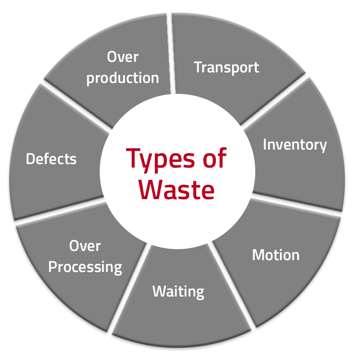The Toyota Production System has long been recognised as a way to eliminate waste – called Muda in Japanese – and achieve high efficiency, influencing many companies worldwide. Waste does not add any value to a process, product or service. 100% value added activities should be the goal of any business. Why does understanding waste in a business process matter? Here’s why.
Three fundamental principles: the 3 M’s
.jpg?width=368&height=245&name=Autopilot_TMHBE%20(1).jpg) Muda is not the one and only non-value-adding problem distorting a process. Make sure to tackle Muri and Mura as well.
Muda is not the one and only non-value-adding problem distorting a process. Make sure to tackle Muri and Mura as well.
At its very core, The Toyota Production System wants to make work easier and less burdensome for workers, with a focus on creating meaningful work. Any production flow should run efficiently and at the pace of customer demand. Any activity that consumes resources without creating value for the customer should be eliminated as much as possible. Hence muri, which means overburden.
Mura will most often be expressed in unevenness in an operation, e.g., in distorted takt time. Takt time indicates the speed at which you need to manufacture a product to satisfy customer requirements. If a team swings from being drowned with work and waiting around there is an inconsistency in the way a team works. An inconsistency in customer demand also needs to be considered when trying to improve the process.
Coexisting alongside the above-mentioned concepts, muda or waste can exist in the form of excess inventory, irrelevant steps in the processes, or defective products, a.o.
Muda, actions that do not have a value-increasing effect on the product, takes on two forms:
- Non-value adding actions that still need doing. The best example is safety tests and inspections. These don’t improve the product as such but have to be performed, nevertheless.
- Non-value-adding actions that have no impact on the end product or the integrity of the production process. This is the kind of waste that needs eliminating.
In many cases, however, applying just one solution (e.g., Jidoka or Just-In-Time) will help you address a few types of waste in one go.
Using Muda as a source of continuous improvement
To increase your process efficiency and start lowering costs, the first action you might want to take is to look at what you can cut down on, what you can change or stop doing altogether. To find out what’s possible, you first need to pinpoint which parts of the process are necessary and which are irrelevant. Always keep in mind each action should be valuable to the end product and the customer.
In that respect, lean manufacturing puts focus on those activities that create value and serves to identify the non-value-adding activities within a process. Lean manufacturing operates on a demand system, not forecasting, and considers the entire value stream, i.e., all activities and services used to create an end product. Our 'True North' vision (our ultimate goal) is zero muda – or zero waste if you will – always on a path of continuous improvement (Kaizen).
Taiichi Ohno's 7 Wastes Transform Process Efficiency

Identifying pointless actions becomes even easier for process managers thanks to the father of Kanban, Toyota engineer Taiichi Ohno, who further classified the two types of muda into seven categories of waste: waiting, transporting, processing, inventory, motion, defects/rework, and overproduction. As Lean management matured, other types of waste identified include underutilised human potential, inappropriate systems, and energy and water.
Among the Muda's that Toyota has identified, two themes appear particularly useful in combating quality problems.
Muda in operational processes: This includes all actions related to manufacturing that are not necessary to satisfy customers or achieve the actual goal. Examples include investing in a tool that is not suitable for the task at hand or one that only fits outdated manufacturing processes. To identify this muda, a critical analysis of each workstation is necessary, revising or updating manuals, and regularly pointing out the importance of updating workflows to the teams.
Muda due to irrelevant processes: Too frequent quality checks, excessive packaging, complex analyses, endless meetings, and excessive signatories can lead to losses associated with the production processes. To counteract them, you should prioritise quality over quantity and regularly question existing processes – whether it's related to a meeting or the strength of the packaging.
More efficiency thanks to error avoidance
Mistake proofing, or its Japanese equivalent poka-yoke (pronounced PO-ka yo-KAY), is a method of avoiding (yoke) unintentional errors (poka) to achieve zero-defect production. It is an easy-to-use tool integrated into automatic devices, tools, and fixtures. Poka Yoke can be categorised into two types:
- The preventive form prevents employees from making mistakes.
- The detection feature flags when a step in the procedure has not been executed.
Poka Yoke also includes error protection and the process of creating these devices.
The application of these tools can be illustrated with an example of a manufacturer of component kits that found an easy way to check if all boxes are complete before shipping.
In this case, the company analysed the situation, identified the root cause, and implemented equipment to weigh the small bags containing the various components. Since each element now has a specific weight, the machine immediately detects any bags that deviate from the norm. These bags are then set aside for review. Identifying bags with missing or surplus parts becomes easy and fast.
Streamlining workflow
Identifying the waste in a process is probably half the job to a smoother workflow. As long as you apply the same systematic approach to removing it, you’re on the right path to making your business processes more efficient.

-1.png)


